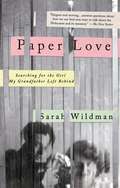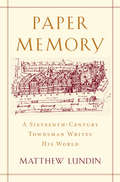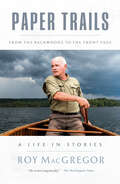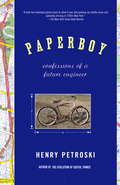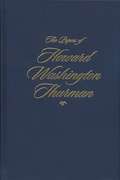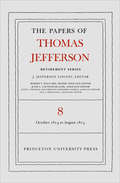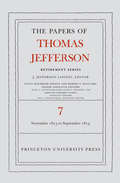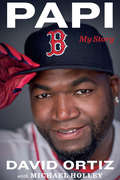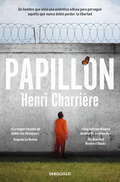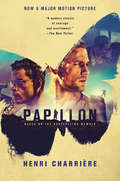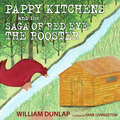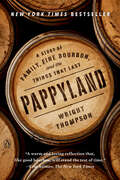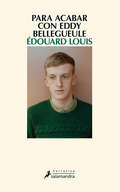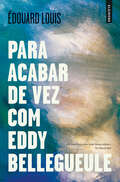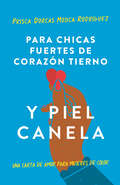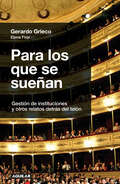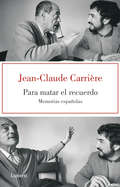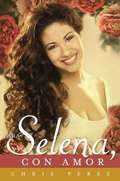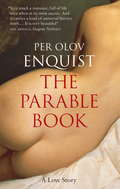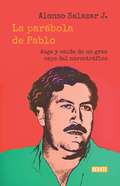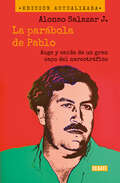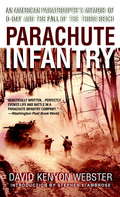- Table View
- List View
Paper Love
by Sarah WildmanOne woman's journey to find the lost love her grandfather left behind when he fled pre-World War II Europe, and an exploration into family identity, myth, and memory. Years after her grandfather's death, journalist Sarah Wildman stumbled upon a cache of his letters in a file labeled "Correspondence: Patients A-G." What she found inside weren't dry medical histories; instead what was written opened a path into the destroyed world that was her family's prewar Vienna. One woman's letters stood out: those from Valy--Valerie Scheftel. Her grandfather's lover who had remained behind when he fled Europe six months after the Nazis annexed Austria. Valy's name wasn't unknown to her--Wildman had once asked her grandmother about a dark-haired young woman whose images she found in an old photo album. "She was your grandfather's true love," her grandmother said at the time, and refused any other questions. But now, with the help of the letters, Wildman started to piece together Valy's story. They revealed a woman desparate to escape and clinging to the memory of a love that defined her years of freedom. Obsessed with Valy's story, Wildman began a quest that lasted years and spanned continents. She discovered, to her shock, an entire world of other people searching for the same woman. On in the course of discovering Valy's ultimate fate, she was forced to reexamine the story of her grandfather's triumphant escape and how this history fit within her own life and in the process, she rescues a life seemingly lost to history.
Paper Memory: A Sixteenth-Century Townsman Writes His World (Harvard historical studies ; #179)
by Matthew LundinPaper Memory tells of one man’s mission to preserve for posterity the memory of everyday life in sixteenth-century Germany. Lundin takes us inside the mind of an undistinguished German burgher, Hermann Weinsberg, whose early-modern writings sought to make sense of changes that were unsettling the foundations of his world.
Paper Son: The Inspiring Story of Tyrus Wong, Immigrant and Artist
by Julie LeungWinner of the American Library Association's 2021 Asian/Pacific American Award for Best Picture Book! An inspiring picture-book biography of animator Tyrus Wong, the Chinese American immigrant responsible for bringing Disney's Bambi to life.Before he became an artist named Tyrus Wong, he was a boy named Wong Geng Yeo. He traveled across a vast ocean from China to America with only a suitcase and a few papers. Not papers for drawing--which he loved to do--but immigration papers to start a new life. Once in America, Tyrus seized every opportunity to make art, eventually enrolling at an art institute in Los Angeles. Working as a janitor at night, his mop twirled like a paintbrush in his hands. Eventually, he was given the opportunity of a lifetime--and using sparse brushstrokes and soft watercolors, Tyrus created the iconic backgrounds of Bambi.Julie Leung and Chris Sasaki perfectly capture the beautiful life and work of a painter who came to this country with dreams and talent--and who changed the world of animation forever.
Paper Trails: From the Backwoods to the Front Page, a Life in Stories
by Roy MacGregorOne of Canada's greatest journalists shares a half century of the stories behind the stories.From his vantage point harnessed to a tree overlooking the town of Huntsville (he tended to wander), a very young Roy MacGregor got in the habit of watching people—what they did, who they talked to, where they went. He has been getting to know his fellow Canadians and telling us all about them ever since. From his early days in the pages of Maclean's, to stints at the Toronto Star, Ottawa Citizen, National Post and most famously from his perch on page two of the Globe and Mail, MacGregor was one of the country's must-read journalists. While news media were leaning increasingly right or left, he always leaned north, his curiosity trained by the deep woods and cold lakes of Algonquin Park to share stories from Canada's farthest reaches, even as he worked in the newsrooms of its southern capitols. From Parliament to the backyard rink, subarctic shores to prairie expanses, MacGregor shaped the way Canadians saw and thought about themselves—never entirely untethered from the land and its history. When MacGregor was still a young editor at Maclean's, the 21-year-old chief of the Waskaganish (aka Rupert's House) Crees, Billy Diamond, found in Roy a willing listener as the chief was appealing desperately to newsrooms across Ottawa, trying to bring attention to the tainted-water emergency in his community. Where other journalists had shrugged off Diamond's appeals, MacGregor got on a tiny plane into northern Quebec. From there began a long friendship that would one day lead MacGregor to a Winnipeg secret location with Elijah Harper and his advisors, a host of the most influential Indigenous leaders in Canada, as the Manitoba MPP contemplated the Charlottetown Accord and a vote that could shatter what seemed at the time the country's last chance to save Confederation. This was the sort of exclusive access to vital Canadian stories that Roy MacGregor always seemed to secure. And as his ardent fans will discover, the observant small-town boy turned pre-eminent journalist put his rare vantage point to exceptional use. Filled with reminiscences of an age when Canadian newsrooms were populated by outsized characters, outright rogues and passionate practitioners, the unputdownable Paper Trails is a must-read account of a life lived in stories.
Paperboy: Confessions of a Future Engineer
by Henry PetroskiHenry Petroski has been called "the poet laureate of technology." He is one of the most eloquent and inquisitive science and engineering writers of our time, illuminating with new clarity such familiar objects as pencils, books, and bridges. In Paperboy, he turns his intellectual curiosity inward, on his own past. Petroski grew up in the Cambria Heights section of New York City's borough of Queens during the 1950s, in the midst of a close and loving family. Educated at local Catholic schools, he worked as a delivery boy for the Long Island Press. The job taught him lessons about diligence, labor, commitment, and community-mindedness, lessons that this successful student could not learn at school. From his vantage point as a professor, engineer, and writer, Petroski reflects fondly on these lessons, and on his near-idyllic boyhood. Paperboy is also the story of the intellectual maturation of an engineer. Petroski's curiosity about how things work--from bicycles to Press-books to newspaper delivery routes--was evident even in his youth. He writes with clear-eyed passion about the physical surroundings of his world, the same attitude he has brought to examining the quotidian objects of our world. Paperboy is a delightful memoir, telling the dual story of an admirable family in a more innocent, bygone America, and the making of an engineer and writer. This is a book to cherish and reread.
The Papers of Howard Washington Thurman, Volume 2: Christian, Who Calls Me Christian? (April 1936-August #1943)
by Howard ThurmanThe Papers of Howard Washington Thurman is a four-volume, chronologically arranged documentary edition spanning the long and productive career of the Reverend Howard Thurman, one of the most significant leaders in the history of intellectual and religious life in the mid-twentieth-century United States. As the first to lead a delegation of African Americans to meet personally with Mahatma Gandhi, in 1936, Thurman would become one of the principal architects of the modern nonviolent Civil Rights Movement and a key mentor to Dr. Martin Luther King, Jr. In 1953 Life magazine named Thurman as one of the twelve greatest preachers of the century. The four volumes of this collection, culled from over 58,000 documents from public and private sources, will feature more than 850 selections of Thurman's sermons, letters, essays, and other writings--most published here for the first time. Each volume will open with an editorial statement, followed by a thematic introductory essay to guide the reader through the dominant themes in Thurman's thought: his understanding of spirituality and social transformations, his creative ecclesiology, and his conception of civic character and the national democratic experiment. Detailed annotations to each document illumine Thurman's personal, professional, and intellectual development and place the texts into their historical context. The volumes are further augmented with detailed chronologies and representative illustrations. Volume 2 (April 1936-August 1943) documents Thurman's years after his return from South Asia and his final years as a professor of philosophy and religion and dean of Rankin Chapel at Howard University. The texts, images, and editorial commentary presented here reveal the maturation of Thurman's theological and social vision, formed by his memories of his time in Asia, his meeting with Gandhi, and his growing commitment to radical nonviolence. His writing also reflects the context of his time, responding to the great events of the day: the Depression, the Great Migration, the birth of the modern Civil Rights Movement, and the coming of World War II. This volume ends immediately prior to Thurman's decision in late 1944 to leave the security of Howard University to copastor a fledgling church in San Francisco, the Church for the Fellowship of All Peoples, one of the first churches in the United States to be organized on an explicitly interracial basis. Critical to understanding the full scope of Thurman's career, the myriad writings gathered in volume 2 also illustrate the early germination of ideas central to the twenty-three books Thurman subsequently authored. Their publication here gives new opportunity to understand these pieces in the context of his life and the genesis of his vision.
The Papers of Thomas Jefferson, Retirement Series: 1 October 1814 to 31 August 1815
by Thomas Jefferson J. Jefferson LooneyVolume Eight of the project documenting Thomas Jefferson's last years presents 591 documents dated from 1 October 1814 to 31 August 1815. Jefferson is overjoyed by American victories late in the War of 1812 and highly interested in the treaty negotiations that ultimately end the conflict. Following Congress's decision to purchase his library, he oversees the counting, packing, and transportation of his books to Washington. Jefferson uses most of the funds from the sale to pay old debts but spends some of the proceeds on new titles. He resigns from the presidency of the American Philosophical Society, revises draft chapters of Louis H. Girardin's history of Virginia, and advises William Wirt on revolutionary-era Stamp Act resolutions. Jefferson criticizes those who discuss politics from the pulpit, and he drafts a bill to transform the Albemarle Academy into Central College. Monticello visitors Francis W. Gilmer, Francis C. Gray, and George Ticknor describe the mountaintop and its inhabitants, and Gray's visit leads to an exchange with Jefferson about how many generations of white interbreeding it takes to clear Negro blood. Finally, although death takes his nephew Peter Carr and brother Randolph Jefferson, the marriage of his grandson Thomas Jefferson Randolph is a continuing source of great happiness.
The Papers of Thomas Jefferson, Retirement Series: 28 November 1813 to 30 September 1814
by J. Jefferson Looney Thomas JeffersonThe 526 documents printed in this volume run from 28 November 1813 to 30 September 1814. During this period Jefferson reviews the extant sources on the 1765 Stamp Act crisis to aid William Wirt, a Patrick Henry scholar; records his largely positive impressions of George Washington; and updates a reading list for law students that he had initially drawn up forty years earlier. In the spring of 1814 Jefferson becomes a trustee of the Albemarle Academy, the earliest direct ancestor of the University of Virginia. He is soon actively involved in planning for its establishment, helping to draft rules for governance of the academy's trustees and propose funding options, and he lays out an expansive vision for its future as an institution of higher learning. Jefferson also exchanges ideas on collegiate education with such respected scholars as Thomas Cooper and José Corrêa da Serra. Jefferson's wide-ranging correspondence includes a temperate response to a lengthy letter from Miles King urging the retired president to reflect on his personal religion, and a diplomatic but noncommittal reply to a proposal by Edward Coles that the author of the Declaration of Independence employ his prestige to help abolish slavery. Having learned of the British destruction late in August 1814 of the public buildings in Washington, Jefferson offers his massive book collection as a replacement for the Library of Congress. The nucleus for one of the world's great public libraries is formed early in 1815 when the nation purchases Jefferson's 6,707 volumes.
Papi: My Story
by David Ortiz Michael HolleyThe Red Sox Hall of Famer and World Series MVP tells the story of his life and career in a sports memoir that &“lives up to its &‘no-holds-barred&’ billing&” (Washington Post). David &“Big Papi&” Ortiz is a baseball icon and one of the most popular figures ever to play the game. A star player with the Boston Red Sox for fifteen years, Ortiz helped to win three World Series, bringing back a storied franchise from &“never wins&” to &“always wins.&” As he launched balls into the stands again and again, he helped silence the naysayers while capturing the imaginations of millions of fans. Ortiz made Boston and the Red Sox his home, his place of work, and his legacy. In Papi, Ortiz tells his story in his own words, opening up as never before. The result is a revelatory tale of a storied career—all told by a legendary player with a lot to say at the end of his time in the game. This edition of Papi includes a new afterword. &“Baseball fans of all loyalties will enjoy learning about [Ortiz&’s] unique experiences in and out of the game.&” —Library Journal &“The rise of Ortiz from scrap-heap bench player to Hall of Famer is an unlikely and entertaining story, and engagingly told.&” —Washington Post
Papillon
by Henri CharrièreUn clásico autobiográfico que relata la increíble evasión de un hombre que vivió una auténtica odisea por perseguir aquello que nunca debió perder: la libertad. <P><P>En 1931, Henri Charrière, apodado Papillon por el tatuaje en forma de mariposa de su pecho, fue condenado a prisión por un asesinato que no había cometido. Sentenciado a cadena perpetua en una colonia penal de la Guayana Francesa, en su mente solo cabía una meta: escapar. <P>Tras varios intentos fallidos de fuga a lo largo de los años, fue enviado a la llamada Isla del Diablo, de donde ningún recluso se había evadido jamás... hasta su llegada. <P>La lucha por la libertad de Papillon sigue siendo una de las más increíbles hazañas que el ingenio, el tesón y la valentía humanos hayan demostrado jamás. Su relato dio lugar a esta extraordinaria autobiografía, la odisea de un hombre inocente para perseguir lo que nunca debió perder: la libertad.
Papillon
by Henri CharriereHenri CharriÈre, called "Papillon," for the butterfly tattoo on his chest, was convicted in Paris in 1931 of a murder he did not commit. Sentenced to life imprisonment in the penal colony of French Guiana, he became obsessed with one goal: escape. After planning and executing a series of treacherous yet failed attempts over many years, he was eventually sent to the notorious prison, Devil's Island, a place from which no one had ever escaped . . . until Papillon. His flight to freedom remains one of the most incredible feats of human cunning, will, and endurance ever undertaken. CharriÈre's astonishing autobiography, Papillon, was published in France to instant acclaim in 1968, more than twenty years after his final escape. Since then, it has become a treasured classic -- the gripping, shocking, ultimately uplifting odyssey of an innocent man who would not be defeated.
Papillon
by Henri CharrièreUn clásico autobiográfico que relata la increíble evasión de un hombre que vivió una auténtica odisea por perseguir aquello que nunca debió perder: la libertad. En 1931, Henri Charrière, apodado Papillon por el tatuaje en forma de mariposa de su pecho, fue condenado a prisión por un asesinato que no había cometido. Sentenciado a cadena perpetua en una colonia penal de la Guayana Francesa, en su mente solo cabía una meta: escapar. Tras varios intentos fallidos de fuga a lo largo de los años, fue enviado a la llamada Isla del Diablo, de donde ningún recluso se había evadido jamás... hasta su llegada. La lucha por la libertad de Papillon sigue siendo una de las más increíbles hazañas que el ingenio, el tesón y la valentía humanos hayan demostrado jamás. Su relato dio lugar a esta extraordinaria autobiografía, la odisea de un hombre inocente para perseguir lo que nunca debió perder: la libertad. Reseñas:«La mayor hazaña de todos los tiempos.»Auguste Le Breton «Un clásico moderno de coraje.»The New Yorker «Una extraordinaria historia de aventuras.»The New York Review of Books
Pappy Kitchens and the Saga of Red Eye the Rooster
by William DunlapO. W. “Pappy” Kitchens (1901–1986) was born in Crystal Springs, Mississippi, and began painting at age sixty-seven. His self-taught, narrative, visual art springs directly from the oral tradition of parable and storytelling with which he grew up. A self-declared folk artist, Kitchens claimed, “I paint about folks, what folks see and what folks do.” His magnum opus, The Saga of Red Eye the Rooster, was painted between 1973 and 1976 and presents a homespun Pilgrim’s Progress in the form of a beast fable. Kitchens’s most ambitious allegorical work, this fable consists of sixty panels, each one measuring fifteen inches square, composed of mixed materials on paper, and executed in three groups of twenty. Kitchens follows Red Eye from foundling to funeral, exploring the life of this extraordinary bird. Red Eye’s quasi-human behavior inevitably maneuvers him into conflicts with antagonists of all sorts. He encounters violence, avarice, lust, greed, and most of the other seven deadly sins, dispatching them in heroic fashion until he finally succumbs to his own fatal flaw. In addition to The Saga of Red Eye the Rooster, the volume features personal photos of Kitchens as well as additional works by the artist. Written by distinguished artist and Kitchens’s once son-in-law William Dunlap, with an introduction by renowned curator Jane Livingston, Pappy Kitchens and the Saga of Red Eye the Rooster brings much-needed exposure to the life and work of a key Mississippi figure.
Pappyland: A Story of Family, Fine Bourbon, and the Things That Last
by Wright ThompsonThe story of how Julian Van Winkle III, the caretaker of the most coveted cult Kentucky Bourbon whiskey in the world, fought to protect his family's heritage and preserve the taste of his forebears, in a world where authenticity, like his product, is in very short supply. <p><p> As a journalist said of Pappy Van Winkle, "You could call it bourbon, or you could call it a $5,000 bottle of liquified, barrel-aged unobtanium." Julian Van Winkle, the third-generation head of his family's business, is now thought of as something like the Buddha of Bourbon - Booze Yoda, as Wright Thompson calls him. He is swarmed wherever he goes, and people stand in long lines to get him to sign their bottles of Pappy Van Winkle Family Reserve, the whiskey he created to honor his grandfather, the founder of the family concern. A bottle of the 23-year-old Pappy starts at $3000 on the internet. As Julian is the first to say, things have gone completely nuts. <p> Forty years ago, Julian would have laughed in astonishment if you'd told him what lay ahead. He'd just stepped in to try to save the business after his father had died, partly of heartbreak, having been forced to sell the old distillery in a brutal downturn in the market for whiskey. Julian's grandfather had presided over a magical kingdom of craft and connoisseurship, a genteel outfit whose family ethos generated good will throughout Kentucky and far beyond. There's always a certain amount of romance to the marketing of spirits, but Pappy's mission statement captured something real: "We make fine bourbon - at a profit if we can, at a loss if we must, but always fine bourbon." But now the business had hit the wilderness years, and Julian could only hang on for dear life, stubbornly committed to preserving his namesake's legacy or going down with the ship. <p> Then something like a miracle happened: it turned out that hundreds of very special barrels of whiskey from the Van Winkle family distillery had been saved by the multinational conglomerate that bought it. With no idea what they had, they offered to sell it to Julian, who scrambled to beg and borrow the funds. Now he could bottle a whiskey whose taste captured his family's legacy. The result would immediately be hailed as the greatest whiskey in the world - and would soon be the hardest to find. <p> But now, those old barrels were used up, and Julian Van Winkle faced the challenge of his lifetime: how to preserve the taste of Pappy, the taste of his family's heritage, in a new age? The amazing Wright Thompson was invited to be his wingman as he set about to try. The result is an extraordinary testimony to the challenge of living up to your legacy and the rewards that come from knowing and honoring your people and your craft. Wright learned those lessons from Julian as they applied to the honest work of making a great bourbon whiskey in Kentucky, but he couldn't help applying them to his own craft, writing, and his upbringing in Mississippi, as he and his wife contemplated the birth of their first child. May we all be lucky enough to find some of ourselves, as Wright Thompson did, in Julian Van Winkle, and in Pappyland. <p> <b>A New York Times Bestseller</b>
Para acabar con Eddy Bellegueule
by Édouard LouisUna rebelión contra el mundo, contra su familia y contra la sociedad. «Excepcional.»Livres Hebdo Salí corriendo de repente. Sólo me dio tiempo a oír a mi madre, que decía Pero ¿qué hace ese idiota? No quería estar con ellos, me negaba a compartir con ellos ese momento. Yo estaba ya lejos, había dejado de pertenecer a su mundo, la carta lo decía. Salí al campo y estuve andando gran parte de la noche: el ambiente fresco del norte, los caminos de tierra, el olor de la colza, muy intenso en esa época del año. Dediqué toda la noche a elaborar mi nueva vida, lejos de allí. «La verdad es que la rebelión contra mis padres, contra la pobreza, contra mi clase social, su racismo, su violencia, sus atavismos, fue algo secundario. Porque, antes de que me alzara contra el mundo de mi infancia, el mundo de mi infancia se había alzado contra mí. Para mi familia y los demás, me había convertido en una fuente de vergüenza, incluso de repulsión. No tuve otra opción que la huida. Este libro es un intento de comprenderla.»Édouard Louis La crítica ha dicho...«Un lenguaje contenido y a la vez brutal, sin victimismos ni exaltaciones líricas [...]. A su escritura clásica, el autor opone la lengua de su entorno, que mezcla jerga local y sintaxis rota. Efectivamente, la violencia social se ejerce con el lenguaje.»Les Inrockuptibles «Magnífico [...]. Es el anuncio de una liberación y de un renacimiento a través de las palabras para escapar de la fatalidad del determinismo social.»Le Point «Tejer un texto uniendo dos registros lingüísticos tan opuestos es más que una proeza. El éxito literario es innegable.»Le Nouvel Observateur «Una narración asombrosa, a causa de la historia personal del autor, pero también de su talento.»Madame Figaro «Excepcional. Un cóctel de Zola y Dickens. Dura, a veces casi insoportable, pero también tragicómica, en cierta medida distante, pero en absoluto maniquea.»Livres Hebdo «Es el grito de cólera de un joven que expresa su asco frente al mito tenaz que convierte al proletariado en una bestia valiente, de buen corazón y amante de la vida.»Catherine Simon, Le Monde des Livres «La escritura de Édouard Louis, con su obstinación en hablar de la vergüenza, demuestra que su libro, que cae como un mazo sobre personas concretas, revela un escándalo universal de primera magnitud.»Jean Birnbaum, Le Monde des Livres
Para Acabar de Vez com Eddy Bellegueule
by Édouard LouisPrimeiro romance de Edouard Louis, que lhe valeu o imediato aplauso da crítica e a fama internacional. Criado no seio de uma família da classe trabalhadora, na Picardia, interior da França, Eddy não é igual às outras crianças. Os seus modos, a sua maneira de falar e a sua delicadeza valeram-lhe humilhações, ameaças e a incompreensão, tanto por parte dos colegas de escola, como do pai, «um duro», alcoólico e irascível, e da mãe, uma mulher cansada e alheada. Eddy cresce assim, preso na contradição de tanto gostar como odiar a pessoa que é, do fascínio e asco pelos seus desejos mais íntimos, de querer a liberdade de uma outra vida, mas nunca conseguindo colocar verdadeiramente de parte o seu amor pelos pais. Primeiro romance de Edouard Louis, que lhe valeu o imediato aplauso da crítica e a fama internacional, Para Acabar de Vez com Eddy Bellegueule é um livro audacioso, feito de memória pessoal e de ficção, um romance temerário e franco, que procura responder à derradeira pergunta: como pode cada um de nós inventar a sua própria liberdade? Os elogios da crítica: «Um romance de uma força e de uma verdade emocionantes.» — Annie Ernaux «Uma história impressionante acerca da diferença e da adolescência.» — The New York Times «O início de uma fulgurante carreira literária.» — The Washington Post«De uma força emocional devastadora.» — The New Yorker
Para chicas fuertes de corazón tierno y piel canela: Una carta de amor para mujeres de color
by Prisca Dorcas Mojica Rodríguez“A través de su íntima manera de narrar y su cálido abrazo a las mujeres de color para quienes escribe, Mojica Rodríguez también abraza dulcemente a los lectores y los invita a transitar el duro camino a la liberación” —POPSUGAR LATINA “Provocador e iluminador. Bella y honestamente escrito, llegará al corazón de las mujeres de color que trabajan por la justicia y la equidad” —SEATTLE BOOK REVIEW Durante generaciones, las mujeres de color han tenido que luchar contra las poderosas fuerzas del sexismo, el racismo y el clasismo; una lucha bastante solitaria. Cuando Prisca Dorca Mojicas fundó Latina Rebels, creó también una comunidad que las ayuda a pelear juntas. Lo hizo de nuevo con este libro. Para chicas fuertes, de corazón tierno y piel canela ofrece sabiduría y caminos de liberación, maneras poderosas de enfrentar diversos retos y empodera a las mujeres para que desafíen la narrativa blanca y masculina contando sus propias historias. Esta es una guía hacia el orgullo y hermandad para las mujeres de piel canela y piel negra, una herramienta necesaria para avivar todo un movimiento. Tal vez prenda una chispa dentro de ti.
Para los que se sueñan: Gestión de instituciones y otros relatos detrás del telón
by Gerardo Grieco Elena FirpiEste libro es el relato de un sueño hecho realidad, pero también es una lección de liderazgo y una inspiración para emprendedores de cualquier área. ¿Se puede gestionar la cultura en el Uruguay? ¿Es posible construir proyectos sostenibles que respeten al público y al artista? ¿Cuál es el límite entre los sueños y la realidad? ¿Dónde termina el arte y comienza la gestión? Este libro cuenta una historia: la de Gerardo Grieco y el difícil camino en la gestión de instituciones culturales. Desde la concreción en 1990 del espectáculo Ámbitos donde Fernando Cabrera y Eduardo Darnauchans se presentaban en el principal escenario del país, hasta la quijotada de llevar “un pueblo al Solís” en 2010. Desde las épocas de regalar jazmines a los transeúntes en el Parque Rodó, hasta la conducción de la más importante transformación en la historia del Teatro Solís. Desde la posición cómoda del éxito obtenido, al riesgo que implica abandonarla para aventurarse tras nuevos objetivos. Las páginas de este libro nos muestran que los sueños se pueden alcanzar, en equipo, con trabajo y constancia, con respeto por las ideas de los demás, y sobre todo, con mucho tesón. Ante la cultura del “acá no se puede” y el “es difícil cambiar”, un conjunto de mujeres y hombres lograron lo que parecía imposible, señalando un camino que resulta inspirador para los trabajadores de la cultura y para cualquiera que sueñe con emprender un proyecto.
Para matar el recuerdo: Memorias españolas
by Jean-Claude CarrièreEl extraordinario relato de la relación con España de Jean-Claude Carrière, el guionista de Buñuel. A lo largo de su rica y variada vida profesional en el mundo del cine, Jean-Claude Carrière ha sido testigo privilegiado de la historia de España en los últimos cincuenta años. Colaborador predilecto de Luis Buñuel en los guiones de películas ya clásicas como Diario de una camarera, El discreto encanto de la burguesía, La Vía Láctea o Ese oscuro objeto del deseo, Carrière evoca en este libro su larga relación con nuestro país, desde que en su infancia viera aparecer a dos niños republicanos en su colegio hasta su época de intenso trabajo con Buñuel, que supuso para el joven guionista el descubrimiento de un mundo perdido, de una España que ya sólo existía en la memoria del cineasta aragonés, aunque todavía pudieran visitar juntos algunos de sus escenarios. De la mano de Buñuel, Carrière conoció también a otros personajes inmensos como Pepín Bello, José Bergamín, Fernando Rey o Francisco Rabal, protagonistas en este libro de inolvidables escenas nunca antes publicadas. Pero más allá de Buñuel, Carrière habla aquí sobre todo de la esencia del país y de la idiosincrasia de los españoles, de su compleja historia, de su arte, de su insondable misterio.
Para Selena, Con Amor
by Chris PerezUna de las superestrellas más impresionantes y adoradas en la historia de la música latina, Selena fue un fenómemeno del espectáculo quien compartió todo lo que era con sus millones de fans. Su trágica muerte a la temprana edad de veintitrés años privó al mundo de su talento y su potencial ilimitado; a su familia la dejó sin su querido ángel; y a su esposo, Chris Perez, sin el amor de su vida. Por más de una década, Chris se agarró de lo único que le quedaba de su esposa: los recuerdos conmovedores, y en ocasiones dolorosos, de su amor profundo. Ahora, por primera vez, Chris habla sobre su poderosa amistad, su relación prohibida y su floreciente matrimonio interrumpido por la imperdonable muerte de Selena. La conmovedora historia de Chris ofrece una visión única de la sinceridad y vulnerabilidad de Selena ante el amor, su fuerza y convicción para luchar por ese amor, y su fortaleza absoluta al encontrar la paz y tranquilidad con su familia después de que aceptaran al único hombre al que entregó su corazón. Al tiempo que muestra un aspecto de Selena nunca antes revelado y aclara algunas concepciones erróneas sobre su vida y su muerte, Para Selena, con amor es una historia de amor eterno que inmortaliza el corazón y el alma de un ícono extraordinario, inolvidable e irremplazable. Incluye fotos eclusivas. .
The Parable Book
by Per Olov Enquist Deborah Bragan-Turner"The love that dare not speak its name . . ." Sweden, 1949. A boy of 15, cutting across a garden, chances upon a woman of 51. What ensues is cataclysmic, life-altering. All the more because it cannot be spoken of. Can it never be spoken of?Looking back in late old age at an encounter that transformed him suddenly yet utterly, P.O. Enquist, a titan of Swedish letters, has decided to "come out" - but in ways entirely novel and unexpected. He has written the book that smoldered unwritten within him his entire life. The book he had always seen as the one he could not write.This poignant memoir of love as a religious experience - as a modern form of the Resurrection - is also a deeply felt reflection on the transitoriness of friendship, the fraught nature of family relationships, and the importance of giving voice to what cannot be forgotten. A parable as hauntingly intense as any Bergman film.Translated from the Swedish by Deborah Bragan-Turner
The Parable Book
by Per Olov Enquist"The love that dare not speak its name . . ." Sweden, 1949. A boy of 15, cutting across a garden, chances upon a woman of 51. What ensues is cataclysmic, life-altering. All the more because it cannot be spoken of. Can it never be spoken of?Looking back in late old age at an encounter that transformed him suddenly yet utterly, P.O. Enquist, a titan of Swedish letters, has decided to "come out" - but in ways entirely novel and unexpected. He has written the book that smoldered unwritten within him his entire life. The book he had always seen as the one he could not write.This poignant memoir of love as a religious experience - as a modern form of the Resurrection - is also a deeply felt reflection on the transitoriness of friendship, the fraught nature of family relationships, and the importance of giving voice to what cannot be forgotten. A parable as hauntingly intense as any Bergman film.Translated from the Swedish by Deborah Bragan-Turner
La parábola de Pablo
by Alonso SalazarBiografía definitiva de Pablo Escobar. Con realismo y gran sentido narrativo compone los claroscuros de uno de los peores criminales de la historia. En La parábola de Pablo, Alonso Salazar presenta dimensiones íntimas, cuadros complejos, humanos y brutales del hombre que se convirtió en el mayor capo de la droga del mundo moderno y en un sanguinario que arrinconó a la sociedad en la que vivió con su imperio de poder, riqueza y delirio y su posterior caída . Este libro inspiró la famosa serie El patrón del mal, cuya aparición 2012 le dio un segundo aire al libro. Para la presente recuperación en Debate tendremos un prólogo de Andrés Parra, el actor que hizo de Escobar en la serie. Alonso Salazar es uno de los cronistas más lúcidos del país. No nacimos pa'semilla, Luis Carlos Galán, profeta en el desierto y No hubo fiesta. Crónicas de la revolución y la contrarrevolución, prueban su capacidad como periodista y su agudeza para abordar los temas más oscuros de la realidad nacional.
La parabola de Pablo (Nueva edición): Auge y caída de un gran capo del narcotráfico
by Alonso SalazarLa parábola de Pablo es ya un clásico de la literatura colombiana. Desde su primera publicación en el 2001 se ha mantenido como la biografía más completa sobre el siniestro capo del cartel de Medellín que ha inspirado, entre otras, la famosa serie Escobar, el patrón del mal. A punto de cumplirse 30 años de la muerte de Pablo Escobar, los lectores podrán contar con una versión revisada que incluye un capítulo nuevo sobre las fuentes consultadas por el autor para la actualización del libro en su totalidad. En La parábola de Pablo, Salazar presenta dimensiones íntimas y cuadros complejos, humanos y brutales del hombre que se convirtió en el mayor capo de la droga del mundo moderno y en un sanguinario que arrinconó a la sociedad en la que vivió con su imperio de poder, riqueza y delirio. "Salazar logra con estricto detalle desentrañar una a una las capas que componen el monstruo, pero lo más importante, logra revelarnos a esa monstruosa, hipócrita y doble sociedad que también fue cómplice. Nos da una bofetada, revela una verdad demoledora: Escobar nunca estuvo solo, su escalofriante maquinaria de muerte, crimen, prostitución, corrupción y narcotráfico estaba aceitada por un enorme grupo de ilustres que incluso hoy se pavonean como si aquí nunca hubiera pasado nada". Andrés Parra
Parachute Infantry: An American Paratrooper's Memoir of D-Day and the Fall of the Third Reich
by David Webster<p>David Kenyon Webster's memoir is a clear-eyed, emotionally charged chronicle of youth, camaraderie, and the chaos of war. Relying on his own letters home and recollections he penned just after his discharge, Webster gives a first hand account of life in E Company, 101st Airborne Division, crafting a memoir that resonates with the immediacy of a gripping novel. <p>From the beaches of Normandy to the blood-dimmed battlefields of Holland, here are acts of courage and cowardice, moments of irritating boredom punctuated by moments of sheer terror, and pitched urban warfare. Offering a remarkable snapshot of what it was like to enter Germany in the last days of World War II, Webster presents a vivid, varied cast of young paratroopers from all walks of life, and unforgettable glimpses of enemy soldiers and hapless civilians caught up in the melee. <p><i>Parachute Infantry</i> is at once harsh and moving, boisterous and tragic, and stands today as an unsurpassed chronicle of war--how men fight it, survive it, and remember it. NOTE: This edition does not include photos.</p>
